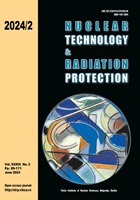
RELATION OF THE AMBIENT DOSE EQUIVALENT RATE IN AIR AND THE AMOUNT OF PRECIPITATION DURING ENVIRONMENTAL MONITORING IN THE VICINITY OF NUCLEAR FACILITIES
Pages: 146-153
Authors: Vesna M. Radumilo, Miloš V. Djaletić, and Aco J. JanićijevićAbstract
Environmental radiation monitoring involves measuring the level of radioactive contamination of the air, including the relevant meteorological measurements at the micro-location type of measurements, which are essential for evaluating the extent of environmental factors and effectively managing the exposure of the population and the impact on the environment. These measurements are crucial in ensuring a comprehensive understanding of the ecological conditions and facilitating informed decision-making to safeguard the well-being of communities and ecosystems. This paper shows the relation between the change of ambient dose equivalent H*(10) rate in the air and precipitation due to washing out and rainout in the atmosphere. Measurements were made in the vicinity of nuclear facilities within the public company Nuclear Facilities of Serbia at the weather station mounting pole 114 m above sea level. To illustrate the relationship between the measured ambient dose equivalent H*(10) rate and precipitation levels, a variation of these values was employed specifically during the most rain-laden months in 2019 and 2020. Besides, an interlaboratory comparison was conducted to ascertain the system's operational validation. A thorough examination of this ratio distinctly reveals the impact of heavy rainfall on the ambient dose equivalent H*(10) rate, thereby rationalizing the observed elevated values. Importantly, these heightened readings were not attributed to any inadvertent release of radioactive effluents from nuclear facility operations in this particular instance.
Key words: monitoring, environment, meteorological parameter, precipitation, nuclear facility
FULL PAPER IN PDF FORMAT (1,57 MB)
